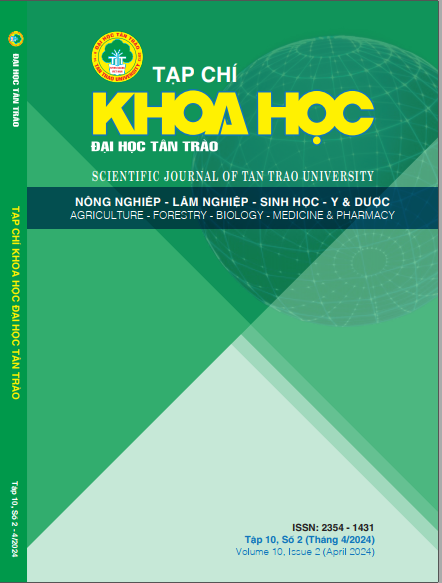NGHIÊN CỨU CÁC YẾU TỐ ẢNH HƯỞNG ĐẾN QUÁ TRÌNH LÊN MEN NƯỚC ÉP TỪ QUẢ DỨA
DOI:
https://doi.org/10.51453/2354-1431/2024/1078Tóm tắt
Nước trái cây lên men là sản phẩm giàu dinh dưỡng và rất được ưa chuộng hiện nay. Nghiên cứu này nhằm khảo sát ảnh hưởng của một số yếu tố đến quá trình lên men nước ép từ quả dứa như nồng độ chất khô tan, độ pH ban đầu của dịch quả, tỷ lệ nấm men bổ sung và thời gian lên men. Kết quả cho thấy, nước ép dứa thành phẩm sau lên men có nồng độ cồn đạt 4,07%v và hàm lượng đường sau lên men còn lại thấp chỉ 6,57 oBx khi dịch lên men ban đầu được điều chỉnh với nồng độ chất khô tan là 20 oBx, pH = 3,8, tỷ lệ nấm men bổ sung là 0,03% và thời gian lên men là 96 giờ. Thành phẩm có điểm cảm quan cao theo TCVN 3215-79, có mùi thơm nhẹ của cồn và hương vị hài hoà.
Tải xuống
Tài liệu tham khảo
Akubor, P.I., Obio, S.O., Nwadomere, K.A. and Obiomah, E (2003). Production and qualityevaluation of banana wine. Plant Foods forHuman Nutrition, 58(3): 1-6.
Cagno, R.D., Filannino, P., & Gobbetti, M (2016). Fermented Foods: Fermented Vegetables and Other Products. Agricultural and Food Sciences, 668 - 674.
Duong D.T (2020). Sustainable development for Vietnam agriculture. Web Conf, 175:1–9.
Nguyen M. T (2013). Stablization and improving the quality of Rose myrtle wine using chemical and biological methods. Can Tho University Journal of Science, 14: 195-204.
Luong D. P (2010). Fermentation technology.Viet Nam Education Publishing House.
Nguyen-Viet H., Tuyet-Hanh T.T., Unger F., Dang-Xuan S. and Grace D (2017). Food safety in Vietnam: Where we are at and what we can learn from international experiences. Infect. Dis. Poverty, 6:1–6.
Phong H.X., Klanrit P., Dung N.T.P., Yamada M. and Thanonkeo P. (2019). Isolation and characterization of thermotolerant yeasts for the production of second generation bioethanol, Ann. Microbiol., 69:1–12.
Phong H.X., Quyen M.T., Thanh N.N., Hoang B. and Long D (2017). Selection of high acid producing lactic acid bacteria and potential application in pineapple juice fermentation. Bioprocess Eng., 1:58–64.
Tien D. T. K., Nhung D. T.T., Dieu D. T.H., Thanh N. N., Mi H. T. N and Phong H. X (2021). Study of conditions for processing fermented drinking water from soursop (Annona muricata L.) using yeast Saccharomyces cerevisiae RV002. Vietnam Journal of Science and Technology, 65(5):76-80.
Tran T.H, Van C.K, Nguyen V.M and Tran T.T (2022). Production of a fermented beverage from pineapple (Ananas comosus) by product crumbs. Materials Today: Proceedings, 60: 2034–2042.
Vo T. T. L (2016). Assessment of agri-product value chains in the Mekong Delta: Problems and solutions, Can Tho Univ. J. Sci., 02:100–111.
Vietnam standard TCVN 3215-79 (1979). Sensorial analysis-Method by pointing mark for food products. Ministry of Science and Technology of Vietnam.
Vietnam standard TCVN 8008:2009. Distilled liquors - Determination of alcohol. Ministry of Science and Technology of Vietnam.
Tải xuống
Đã Xuất bản
Cách trích dẫn
Số
Chuyên mục
Giấy phép

Tác phẩm này được cấp phép theo Giấy phép Quốc tế Creative Commons Attribution-ShareAlike 4.0 .
Bài báo được xuất bản ở Tạp chí Khoa học Đại học Tân Trào được cấp phép theo giấy phép Ghi công - Chia sẻ tương tự 4.0 Quốc tế (CC BY-SA). Theo đó, các tác giả khác có thể sao chép, chuyển đổi hay phân phối lại các bài báo này với mục đích hợp pháp trên mọi phương tiện, với điều kiện họ trích dẫn tác giả, Tạp chí Khoa học Đại học Tân Trào và đường link đến bản quyền; nêu rõ các thay đổi đã thực hiện và các nghiên cứu đăng lại được tiến hành theo cùng một bản quyền.
Bản quyền bài báo thuộc về các tác giả, không hạn chế số lượng. Tạp chí Khoa học Tân Trào được cấp giấy phép không độc quyền để xuất bản bài báo với tư cách nhà xuất bản nguồn, kèm theo quyền thương mại để in các bài báo cung cấp cho các thư viện và cá nhân.
Mặc dù các điều khoản của giấy phép CC BY-SA không dành cho các tác giả (với tư cách là người giữ bản quyền của bài báo, họ không bị hạn chế về quyền hạn), khi gửi bài tới Tạp chí Khoa học Đại học Tân Trào, tác giả cần đáp ứng quyền của độc giả, và cần cấp quyền cho bên thứ 3 sử dụng bài báo của họ trong phạm vi của giấy phép.


